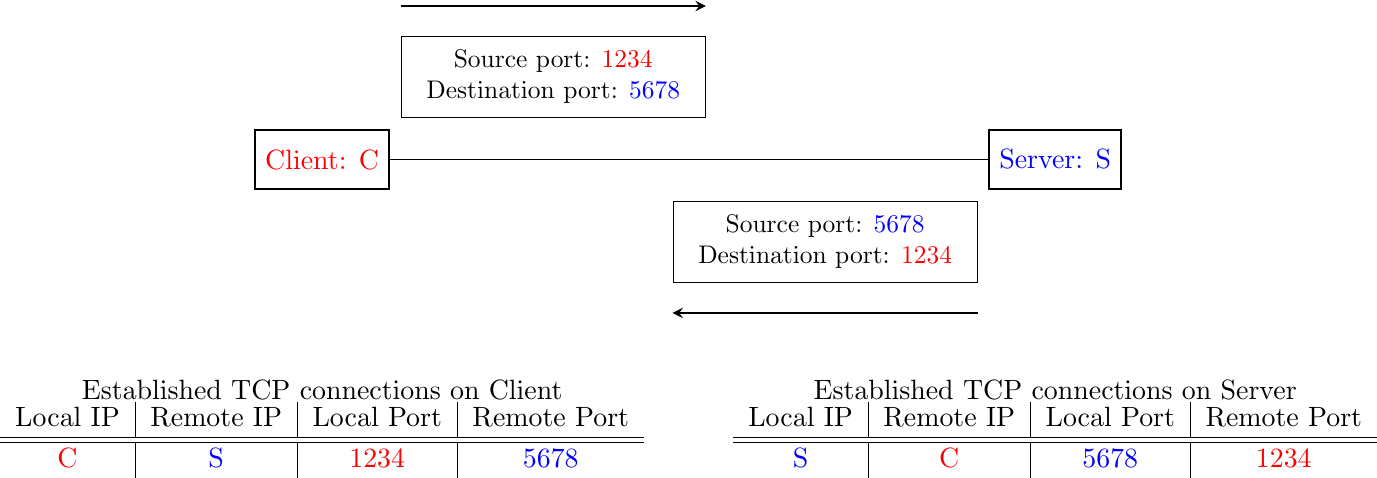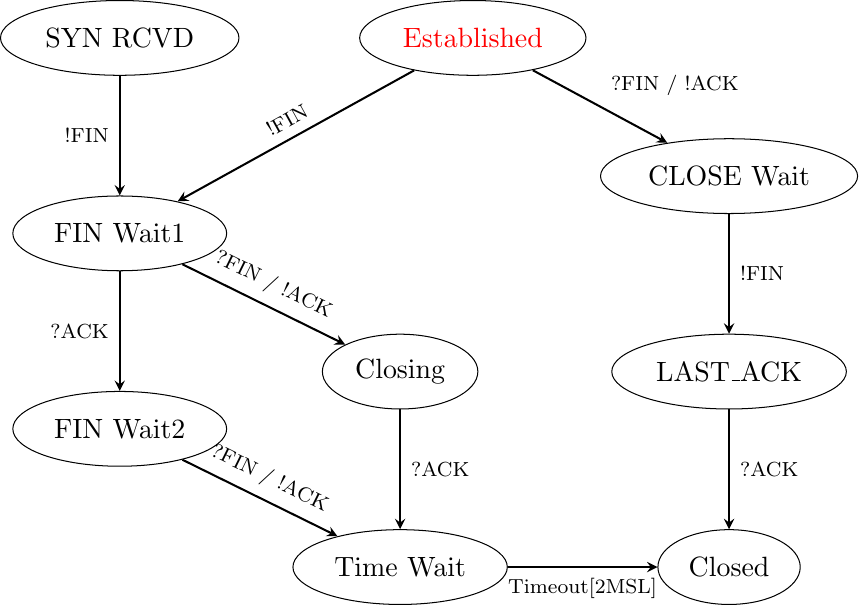The Transmission Control Protocol
Contents
The Transmission Control Protocol¶
The Transmission Control Protocol (TCP) was initially defined in RFC 793. Several parts of the protocol have been improved since the publication of the original protocol specification 1. However, the basics of the protocol remain and an implementation that only supports RFC 793 should inter-operate with today’s implementation.
TCP provides a reliable bytestream, connection-oriented transport service on top of the unreliable connectionless network service provided by IP. TCP is used by a large number of applications, including :
On the global Internet, most of the applications used in the wide area rely on TCP. Many studies 2 have reported that TCP was responsible for more than 90% of the data exchanged in the global Internet.
To provide this service, TCP relies on a simple segment format that is shown in the figure below. Each TCP segment contains a header described below and, optionally, a payload. The default length of the TCP header is twenty bytes, but some TCP headers contain options.
TCP header format¶
A TCP header contains the following fields :
the source and destination ports. The source and destination ports play an important role in TCP, as they allow the identification of the connection to which a TCP segment belongs. When a client opens a TCP connection, it typically selects an ephemeral TCP port number as its source port and contacts the server by using the server’s port number. All the segments that are sent by the client on this connection have the same source and destination ports. The server sends segments that contain as source (resp. destination) port, the destination (resp. source) port of the segments sent by the client (see figure Utilization of the TCP source and destination ports). A TCP connection is always identified by four pieces of information :
the address of the client
the address of the server
the port chosen by the client
the port chosen by the server
the sequence number (32 bits), acknowledgment number (32 bits) and window (16 bits) fields are used to provide a reliable data transfer, using a window-based protocol. In a TCP bytestream, each byte of the stream consumes one sequence number. Their usage is described in more detail in section TCP reliable data transfer
the Urgent pointer is used to indicate that some data should be considered as urgent in a TCP bytestream. However, it is rarely used in practice and will not be described here. Additional details about the utilization of this pointer may be found in RFC 793, RFC 1122 or [Stevens1994]
the flags field contains a set of bit flags that indicate how a segment should be interpreted by the TCP entity receiving it :
the SYN flag is used during connection establishment
the FIN flag is used during connection release
the RST is used in case of problems or when an invalid segment has been received
when the ACK flag is set, it indicates that the acknowledgment field contains a valid number. Otherwise, the content of the acknowledgment field must be ignored by the receiver
the URG flag is used together with the Urgent pointer
the PSH flag is used as a notification from the sender to indicate to the receiver that it should pass all the data it has received to the receiving process. However, in practice TCP implementations do not allow TCP users to indicate when the PSH flag should be set.
the checksum field contains the value of the Internet checksum computed over the entire TCP segment and a pseudo-header as with UDP
the Reserved field was initially reserved for future utilization. It is now used by RFC 3168.
the TCP Header Length (THL) or Data Offset field is a four-bit field that indicates the size of the TCP header in 32 bit words. The maximum size of the TCP header is thus 64 bytes.
the Optional header extension is used to add optional information to the TCP header. Thanks to this header extension, it is possible to add new fields to the TCP header that were not planned in the original specification. This allowed TCP to evolve since the early eighties. The details of the TCP header extension are explained in sections TCP connection establishment and TCP reliable data transfer.
Utilization of the TCP source and destination ports
The rest of this section is organized as follows. We first explain the establishment and the release of a TCP connection, then we discuss the mechanisms that are used by TCP to provide a reliable bytestream service. We end the section with a discussion of network congestion and explain the mechanisms that TCP uses to avoid congestion collapse.
TCP connection establishment¶
A TCP connection is established by using a three-way handshake. The connection establishment phase uses the sequence number, the acknowledgment number and the SYN flag. When a TCP connection is established, the two communicating hosts negotiate the initial sequence number to be used in both directions of the connection. For this, each TCP entity maintains a 32-bit counter, which is supposed to be incremented by one at least every 4 microseconds and after each connection establishment 3. When a client host wants to open a TCP connection with a server host, it creates a TCP segment with :
the SYN flag set
the sequence number set to the current value of the 32-bit counter of the client host’s TCP entity
Upon reception of this segment (which is often called a SYN segment), the server host replies with a segment containing :
the SYN flag set
the sequence number set to the current value of the 32-bit counter of the server host’s TCP entity
the ACK flag set
the acknowledgment number set to the sequence number of the received SYN segment incremented by 1 \(\pmod{2^{32}}\). When a TCP entity sends a segment having x+1 as acknowledgment number, this indicates that it has received all data up to and including sequence number x and that it is expecting data having sequence number x+1. As the SYN flag was set in a segment having sequence number x, this implies that setting the SYN flag in a segment consumes one sequence number.
This segment is often called a SYN+ACK segment. The acknowledgment confirms to the client that the server has correctly received the SYN segment. The sequence number of the SYN+ACK segment is used by the server host to verify that the client has received the segment. Upon reception of the SYN+ACK segment, the client host replies with a segment containing :
the ACK flag set
the acknowledgment number set to the sequence number of the received SYN+ACK segment incremented by 1 \(\pmod{2^{32}}\)
At this point, the TCP connection is open and both the client and the server are allowed to send TCP segments containing data. This is illustrated in the figure below.
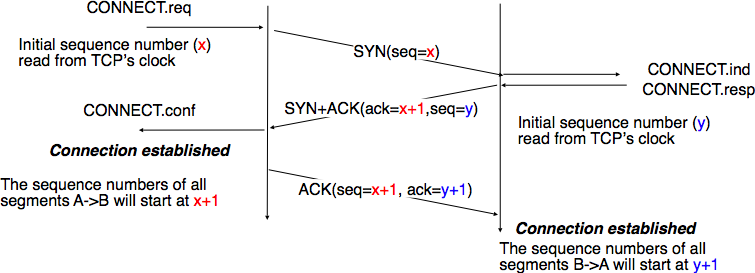
Establishment of a TCP connection¶
In the figure above, the connection is considered to be established by the client once it has received the SYN+ACK segment, while the server considers the connection to be established upon reception of the ACK segment. The first data segment sent by the client (server) has its sequence number set to x+1 (resp. y+1).
Note
Computing TCP’s initial sequence number
In the original TCP specification RFC 793, each TCP entity maintained a clock to compute the initial sequence number (ISN) placed in the SYN and SYN+ACK segments. This made the ISN predictable and caused a security issue. The typical security problem was the following. Consider a server that trusts a host based on its IP address and allows the system administrator to log in from this host without giving a password 4. Consider now an attacker who knows this particular configuration and is able to send IP packets having the client’s address as source. He can send fake TCP segments to the server, but does not receive the server’s answers. If he can predict the ISN that is chosen by the server, he can send a fake SYN segment and shortly after the fake ACK segment confirming the reception of the SYN+ACK segment sent by the server. Once the TCP connection is open, he can use it to send any command to the server. To counter this attack, current TCP implementations add randomness to the ISN. One of the solutions, proposed in RFC 1948 is to compute the ISN as
ISN = M + H(localhost, localport, remotehost, remoteport, secret).
where M is the current value of the TCP clock and H is a cryptographic hash function. localhost and remotehost (resp. localport and remoteport ) are the IP addresses (port numbers) of the local and remote host and secret is a random number only known by the server. This method allows the server to use different ISNs for different clients at the same time. Measurements performed with the first implementations of this technique showed that it was difficult to implement it correctly, but today’s TCP implementations now generate good ISNs.
A server could, of course, refuse to open a TCP connection upon reception of a SYN segment. This refusal may be due to various reasons. There may be no server process that is listening on the destination port of the SYN segment. The server could always refuse connection establishments from this particular client (e.g. due to security reasons) or the server may not have enough resources to accept a new TCP connection at that time. In this case, the server would reply with a TCP segment having its RST flag set and containing the sequence number of the received SYN segment incremented by one as its acknowledgment number. This is illustrated in the figure below. We discuss the other usages of the TCP RST flag later (see TCP connection release).
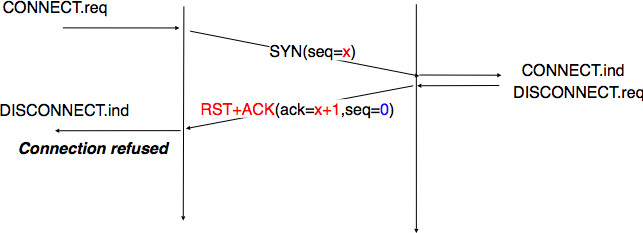
TCP connection establishment rejected by peer¶
TCP connection establishment can be described as the four state Finite State Machine shown below. In this FSM, !X (resp. ?Y) indicates the transmission of segment X (resp. reception of segment Y) during the corresponding transition. Init is the initial state.
TCP FSM for connection establishment
A client host starts in the Init state. It then sends a SYN segment and enters the SYN Sent state where it waits for a SYN+ACK segment. Then, it replies with an ACK segment and enters the Established state where data can be exchanged. On the other hand, a server host starts in the Init state. When a server process starts to listen to a destination port, the underlying TCP entity creates a TCP control block and a queue to process incoming SYN segments. Upon reception of a SYN segment, the server’s TCP entity replies with a SYN+ACK and enters the SYN RCVD state. It remains in this state until it receives an ACK segment that acknowledges its SYN+ACK segment, with this it then enters the Established state.
Apart from these two paths in the TCP connection establishment FSM, there is a third path that corresponds to the case when both the client and the server send a SYN segment to open a TCP connection 5. In this case, the client and the server send a SYN segment and enter the SYN Sent state. Upon reception of the SYN segment sent by the other host, they reply by sending a SYN+ACK segment and enter the SYN RCVD state. The SYN+ACK that arrives from the other host allows it to transition to the Established state. The figure below illustrates such a simultaneous establishment of a TCP connection.
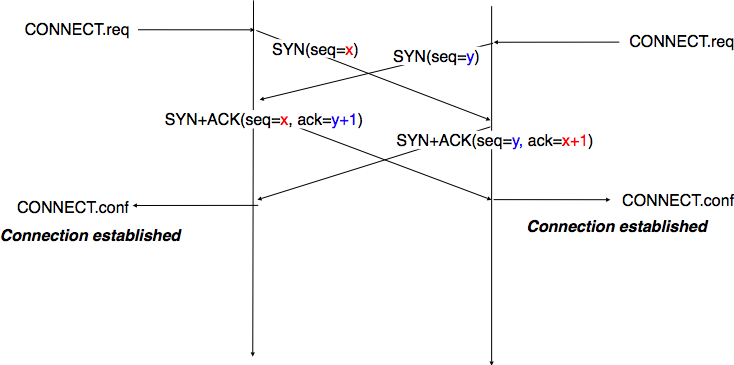
Simultaneous establishment of a TCP connection¶
Denial of Service attacks
When a TCP entity opens a TCP connection, it creates a Transmission Control Block (TCB). The TCB contains the entire state that is maintained by the TCP entity for each TCP connection. During connection establishment, the TCB contains the local IP address, the remote IP address, the local port number, the remote port number, the current local sequence number and the last sequence number received from the remote entity. Until the mid-1990s, TCP implementations had a limit on the number of TCP connections that could be in the SYN RCVD state at a given time. Many implementations set this limit to about 100 TCBs. This limit was considered sufficient even for heavily loaded HTTP servers given the small delay between the reception of a SYN segment and the reception of the ACK segment that terminates the establishment of the TCP connection. When the limit of 100 TCBs in the SYN Rcvd state is reached, the TCP entity discards all received TCP SYN segments that do not correspond to an existing TCB.
This limit of 100 TCBs in the SYN Rcvd state was chosen to protect the TCP entity from the risk of overloading its memory with too many TCBs in the SYN Rcvd state. However, it was also the reason for a new type of Denial of Service (DoS) attack RFC 4987. A DoS attack is defined as an attack where an attacker can render a resource unavailable in the network. For example, an attacker may cause a DoS attack on a 2 Mbps link used by a company by sending more than 2 Mbps of packets through this link. In this case, the DoS attack was more subtle. As a TCP entity discards all received SYN segments as soon as it has 100 TCBs in the SYN Rcvd state, an attacker simply had to send a few 100 SYN segments every second to a server and never reply to the received SYN+ACK segments. To avoid being caught, attackers were of course sending these SYN segments with a different address than their own IP address 6. On most TCP implementations, once a TCB entered the SYN Rcvd state, it remained in this state for several seconds, waiting for a retransmission of the initial SYN segment. This attack was later called a SYN flood attack and the servers of the ISP named Panix were among the first to be affected by this attack.
To avoid the SYN flood attacks, recent TCP implementations no longer enter the SYN Rcvd state upon reception of a SYN segment. Instead, they reply directly with a SYN+ACK segment and wait until the reception of a valid ACK. This implementation trick is only possible if the TCP implementation is able to verify that the received ACK segment acknowledges the SYN+ACK segment sent earlier without storing the initial sequence number of this SYN+ACK segment in a TCB. The solution to solve this problem, which is known as SYN cookies is to compute the 32 bits of the ISN as follows :
the high order bits contain the low order bits of a counter that is incremented slowly
the low order bits contain a hash value computed over the local and remote IP addresses and ports and a random secret only known to the server
The advantage of the SYN cookies is that by using them, the server does not need to create a TCB upon reception of the SYN segment and can still check the returned ACK segment by recomputing the SYN cookie. The main disadvantage is that they are not fully compatible with the TCP options. This is why they are not enabled by default on a typical system.
Retransmitting the first SYN segment
As IP provides an unreliable connectionless service, the SYN and SYN+ACK segments sent to open a TCP connection could be lost. Current TCP implementations start a retransmission timer when they send the first SYN segment. This timer is often set to three seconds for the first retransmission and then doubles after each retransmission RFC 2988. TCP implementations also enforce a maximum number of retransmissions for the initial SYN segment.
As explained earlier, TCP segments may contain an optional header extension. In the SYN and SYN+ACK segments, these options are used to negotiate some parameters and the utilization of extensions to the basic TCP specification.
The first parameter which is negotiated during the establishment of a TCP connection is the Maximum Segment Size (MSS). The MSS is the size of the largest segment that a TCP entity is able to process. According to RFC 879, all TCP implementations must be able to receive TCP segments containing 536 bytes of payload. However, most TCP implementations are able to process larger segments. Such TCP implementations use the TCP MSS Option in the SYN/SYN+ACK segment to indicate the largest segment they are able to process. The MSS value indicates the maximum size of the payload of the TCP segments. The client (resp. server) stores in its TCB the MSS value announced by the server (resp. the client).
Another utilization of TCP options during connection establishment is to enable TCP extensions. For example, consider RFC 1323 (which is discussed in TCP reliable data transfer). RFC 1323 defines TCP extensions to support timestamps and larger windows. If the client supports RFC 1323, it adds a RFC 1323 option to its SYN segment. If the server understands this RFC 1323 option and wishes to use it, it replies with a RFC 1323 option in the SYN+ACK segment and the extension defined in RFC 1323 is used throughout the TCP connection. Otherwise, if the server’s SYN+ACK does not contain the RFC 1323 option, the client is not allowed to use this extension and the corresponding TCP header options throughout the TCP connection. TCP’s option mechanism is flexible and it allows the extension of TCP while maintaining compatibility with older implementations.
The TCP options are encoded by using a Type Length Value format where :
the first byte indicates the type of the option.
the second byte indicates the total length of the option (including the first two bytes) in bytes
the remaining bytes are specific for each type of option
RFC 793 defines the Maximum Segment Size (MSS) TCP option that must be understood by all TCP implementations. This option (type 2) has a length of 4 bytes and contains a 16-bit word that indicates the MSS supported by the sender of the SYN segment. The MSS option can only be used in TCP segments having the SYN flag set.
RFC 793 also defines two special options that must be supported by all TCP implementations. The first option is End of option. It is encoded as a single byte having value 0x00 and can be used to ensure that the TCP header extension ends on a 32-bit boundary. The No-Operation option, encoded as a single byte having value 0x01, can be used when the TCP header extension contains several TCP options that should be aligned on 32-bit boundaries. All other options 7 are encoded using the TLV format.
Note
The robustness principle
The handling of the TCP options by TCP implementations is one of the many applications of the robustness principle which is usually attributed to Jon Postel and is often quoted as “Be liberal in what you accept, and conservative in what you send” RFC 1122.
Concerning the TCP options, the robustness principle implies that a TCP implementation should be able to accept TCP options that it does not understand, in particular in received SYN segments, and that it should be able to parse any received segment without crashing, even if the segment contains an unknown TCP option. Furthermore, a server should not send in the SYN+ACK segment or later, options that have not been proposed by the client in the SYN segment.
TCP reliable data transfer¶
The original TCP data transfer mechanisms were defined in RFC 793. Based on the experience of using TCP on the growing global Internet, this part of the TCP specification has been updated and improved several times, always while preserving the backward compatibility with older TCP implementations. In this section, we review the main data transfer mechanisms used by TCP.
TCP is a window-based transport protocol that provides a bi-directional byte stream service. This has several implications on the fields of the TCP header and the mechanisms used by TCP. The three fields of the TCP header are :
sequence number. TCP uses a 32 bits sequence number. The sequence number placed in the header of a TCP segment containing data is the sequence number of the first byte of the payload of the TCP segment.
acknowledgment number. TCP uses cumulative positive acknowledgments. Each TCP segment contains the sequence number of the next byte that the sender of the acknowledgment expects to receive from the remote host. In theory, the acknowledgment number is only valid if the ACK flag of the TCP header is set. In practice, almost all 8 TCP segments have their ACK flag set.
window. a TCP receiver uses this 16 bits field to indicate the current size of its receive window expressed in bytes.
Note
The Transmission Control Block
For each established TCP connection, a TCP implementation must maintain a Transmission Control Block (TCB). A TCB contains all the information required to send and receive segments on this connection RFC 793. This includes 9 :
the local IP address
the remote IP address
the local TCP port number
the remote TCP port number
the current state of the TCP FSM
the maximum segment size (MSS)
snd.nxt : the sequence number of the next byte in the byte stream (the first byte of a new data segment that you send uses this sequence number)
snd.una : the earliest sequence number that has been sent but has not yet been acknowledged
snd.wnd : the current size of the sending window (in bytes)
rcv.nxt : the sequence number of the next byte that is expected to be received from the remote host
rcv.wnd : the current size of the receive window advertised by the remote host
sending buffer : a buffer used to store all unacknowledged data
receiving buffer : a buffer to store all data received from the remote host that has not yet been delivered to the user. Data may be stored in the receiving buffer because either it was not received in sequence or because the user is too slow to process it
The original TCP specification can be summarized as a transport protocol that provides a byte stream service and uses go-back-n with a selective-repeat reception strategy.
To send new data on an established connection, a TCP entity performs the following operations on the corresponding TCB. It first checks that the sending buffer does not contain more data than the receive window advertised by the remote host (rcv.wnd). If the window is not full, up to MSS bytes of data are placed in the payload of a TCP segment. The sequence number of this segment is the sequence number of the first byte of the payload. It is set to the first available sequence number, snd.nxt, and snd.nxt is incremented by the length of the payload of the TCP segment. The acknowledgment number of this segment is set to the current value of rcv.nxt and the window field of the TCP segment is computed based on the current occupancy of the receiving buffer. The data is kept in the sending buffer in case it needs to be retransmitted later.
When a TCP segment with the ACK flag set is received, the following operations are performed. rcv.wnd is set to the value of the window field of the received segment. The acknowledgment number is compared to snd.una. The newly acknowledged data is removed from the sending buffer and snd.una is updated. If the TCP segment contained data, the sequence number is compared to rcv.nxt. If they are equal, the segment was received in sequence and the data can be delivered to the user and rcv.nxt is updated. The contents of the receiving buffer is checked to see whether other data already present in this buffer can be delivered in sequence to the user. If so, rcv.nxt is updated again. Otherwise, the segment’s payload is placed in the receiving buffer.
Segment transmission strategies¶
In a transport protocol such as TCP that offers a bytestream, a practical issue that was left as an implementation choice in RFC 793 is to decide when a new TCP segment containing data must be sent. There are two simple and extreme implementation choices. The first implementation choice is to send a TCP segment as soon as the user has requested the transmission of some data. This allows TCP to provide a low delay service. However, if the user is sending data one byte at a time, TCP would place each user byte in a segment containing 20 bytes of TCP header 10. This is a huge overhead that is not acceptable in wide area networks. A second simple solution would be to only transmit a new TCP segment once the user has produced MSS bytes of data. This solution reduces the overhead, but at the cost of a potentially very high delay.
An elegant solution to this problem was proposed by John Nagle in RFC 896. John Nagle observed that the overhead caused by the TCP header was a problem in wide area connections, but less in local area connections where the available bandwidth is usually higher. He proposed the following rules to decide to send a new data segment when a new data has been produced by the user or a new ack segment has been received.
if rcv.wnd >= MSS and len(data) >= MSS:
send one MSS-sized segment
else:
if there are unacknowledged data:
place data in buffer until acknowledgment has been received
else:
send one TCP segment containing all buffered data (up to rcv.wnd)
The first rule ensures that a TCP connection used for bulk data transfer always sends full TCP segments. The second rule sends one partially filled TCP segment every round-trip-time.
This algorithm, called the Nagle algorithm, takes a few lines of code in all TCP implementations. These lines of code have a huge impact on the packets that are exchanged in TCP/IP networks. Researchers have analyzed the distribution of the packet sizes by capturing and analyzing all the packets passing through a given link. These studies have shown several important results :
in TCP/IP networks, a large fraction of the packets are TCP segments that contain only an acknowledgment. These packets usually account for 40-50% of the packets passing through the studied link
in TCP/IP networks, most of the bytes are exchanged in long packets, usually packets containing about 1440 bytes of payload which is the default MSS for hosts attached to an Ethernet network, the most popular type of LAN
Recent measurements indicate that these packet size distributions are still valid in today’s Internet, although the packet distribution tends to become bi-modal with small packets corresponding to TCP pure acknowledgments and large 1440-bytes packets carrying most of the user data [SMASU2012].
TCP windows¶
From a performance point of view, one of the main limitations of the original TCP specification is the 16 bits window field in the TCP header. As this field indicates the current size of the receive window in bytes, it limits the TCP receive window at 65535 bytes. This limitation was not a severe problem when TCP was designed since at that time high-speed wide area networks offered a maximum bandwidth of 56 kbps. However, in today’s network, this limitation is not acceptable anymore. The table below provides the rough 11 maximum throughput that can be achieved by a TCP connection with a 64 KBytes window in function of the connection’s round-trip-time
RTT |
Maximum Throughput |
|---|---|
1 msec |
524 Mbps |
10 msec |
52.4 Mbps |
100 msec |
5.24 Mbps |
500 msec |
1.05 Mbps |
To solve this problem, a backward compatible extension that allows TCP to use larger receive windows was proposed in RFC 1323. Today, most TCP implementations support this option. The basic idea is that instead of storing snd.wnd and rcv.wnd as 16 bits integers in the TCB, they should be stored as 32 bits integers. As the TCP segment header only contains 16 bits to place the window field, it is impossible to copy the value of snd.wnd in each sent TCP segment. Instead the header contains snd.wnd >> S where S is the scaling factor ( \(0 \le S \le 14\)) negotiated during connection establishment. The client adds its proposed scaling factor as a TCP option in the SYN segment. If the server supports RFC 1323, it places in the SYN+ACK segment the scaling factor that it uses when advertising its own receive window. The local and remote scaling factors are included in the TCB. If the server does not support RFC 1323, it ignores the received option and no scaling is applied.
By using the window scaling extensions defined in RFC 1323, TCP implementations can use a receive buffer of up to 1 GByte. With such a receive buffer, the maximum throughput that can be achieved by a single TCP connection becomes :
RTT |
Maximum Throughput |
|---|---|
1 msec |
8590 Gbps |
10 msec |
859 Gbps |
100 msec |
86 Gbps |
500 msec |
17 Gbps |
These throughputs are acceptable in today’s networks. However, there are already servers having 10 Gbps interfaces… Early TCP implementations had fixed receiving and sending buffers 12. Today’s high performance implementations are able to automatically adjust the size of the sending and receiving buffer to better support high bandwidth flows [SMM1998].
TCP’s retransmission timeout¶
In a go-back-n transport protocol such as TCP, the retransmission timeout must be correctly set in order to achieve good performance. On one hand, if the retransmission timeout expires too early, then bandwidth is wasted by retransmitting segments that have already been correctly received. On the other hand, if the retransmission timeout expires too late, then bandwidth is wasted because the sender is idle waiting for the expiration of its retransmission timeout.
A good setting of the retransmission timeout clearly depends on an accurate estimation of the round-trip-time of each TCP connection. The round-trip-time differs between TCP connections, but may also change during the lifetime of a single connection. For example, the figure below shows the evolution of the round-trip-time between two hosts during a period of 45 seconds.
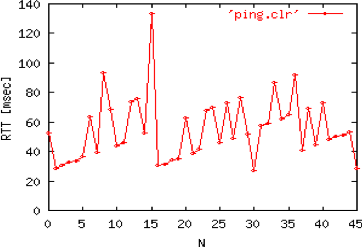
Evolution of the round-trip-time between two hosts¶
The easiest solution to measure the round-trip-time on a TCP connection is to measure the delay between the transmission of a data segment and the reception of a corresponding acknowledgment 13. As illustrated in the figure below, this measurement works well when there are no segment losses.
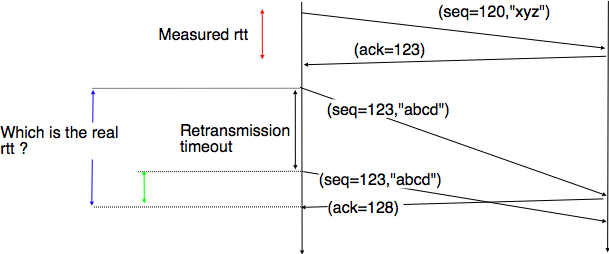
How to measure the round-trip-time ?¶
However, when a data segment is lost, as illustrated in the bottom part of the figure, the measurement is ambiguous as the sender cannot determine whether the received acknowledgment was triggered by the first transmission of segment 123 or its retransmission. Using incorrect round-trip-time estimations could lead to incorrect values of the retransmission timeout. For this reason, Phil Karn and Craig Partridge proposed, in [KP91], to ignore the round-trip-time measurements performed during retransmissions.
To avoid this ambiguity in the estimation of the round-trip-time when segments are retransmitted, recent TCP implementations rely on the timestamp option defined in RFC 1323. This option allows a TCP sender to place two 32 bit timestamps in each TCP segment that it sends. The first timestamp, TS Value (TSval) is chosen by the sender of the segment. It could for example be the current value of its real-time clock 14. The second value, TS Echo Reply (TSecr), is the last TSval that was received from the remote host and stored in the TCB. The figure below shows how the utilization of this timestamp option allows for the disambiguation of the round-trip-time measurement when there are retransmissions.
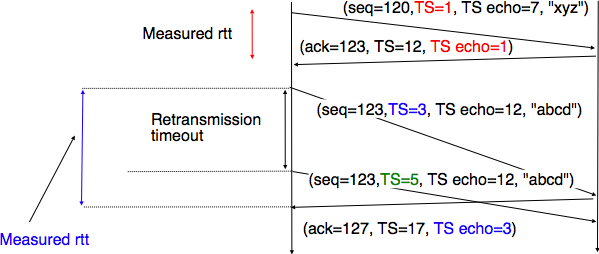
Disambiguating round-trip-time measurements with the RFC 1323 timestamp option¶
Once the round-trip-time measurements have been collected for a given TCP connection, the TCP entity must compute the retransmission timeout. As the round-trip-time measurements may change during the lifetime of a connection, the retransmission timeout may also change. At the beginning of a connection 15, the TCP entity that sends a SYN segment does not know the round-trip-time to reach the remote host and the initial retransmission timeout is usually set to 3 seconds RFC 2988.
The original TCP specification proposed in RFC 793 to include two additional variables in the TCB :
srtt : the smoothed round-trip-time computed as \(srtt=(\alpha \times srtt)+( (1-\alpha) \times rtt)\) where \(rtt\) is the round-trip-time measured according to the above procedure and \(\alpha\) a smoothing factor (e.g. 0.8 or 0.9)
rto : the retransmission timeout is computed as \(rto=\min(60,\max(1,\beta \times srtt))\) where \(\beta\) is used to take into account the delay variance (value : 1.3 to 2.0). The 60 and 1 constants are used to ensure that the rto is not larger than one minute nor smaller than 1 second.
However, in practice, this computation for the retransmission timeout did not work well. The main problem was that the computed rto did not correctly take into account the variations in the measured round-trip-time. Van Jacobson proposed in his seminal paper [Jacobson1988] an improved algorithm to compute the rto and implemented it in the BSD Unix distribution. This algorithm is now part of the TCP standard RFC 2988.
Jacobson’s algorithm uses two state variables, srtt the smoothed rtt and rttvar the estimation of the variance of the rtt and two parameters : \(\alpha\) and \(\beta\). When a TCP connection starts, the first rto is set to 3 seconds. When a first estimation of the rtt is available, the srtt, rttvar and rto are computed as follows :
srtt = rtt
rttvar = rtt/2
rto = srtt + 4*rttvar
Then, when other rtt measurements are collected, srtt and rttvar are updated as follows :
\(rttvar=(1-\beta) \times rttvar + \beta \times |srtt - rtt|\)
\(srtt=(1-\alpha) \times srtt + \alpha \times rtt\)
\(rto=srtt + 4 \times rttvar\)
The proposed values for the parameters are \(\alpha=\frac{1}{8}\) and \(\beta=\frac{1}{4}\). This allows a TCP implementation, implemented in the kernel, to perform the rtt computation by using shift operations instead of the more costly floating point operations [Jacobson1988]. The figure below illustrates the computation of the rto upon rtt changes.
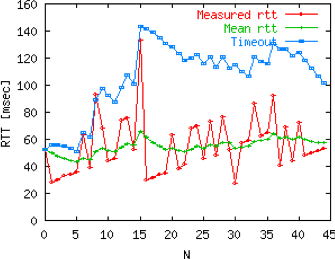
Example computation of the rto¶
Advanced retransmission strategies¶
The default go-back-n retransmission strategy was defined in RFC 793. When the retransmission timer expires, TCP retransmits the first unacknowledged segment (i.e. the one having sequence number snd.una). After each expiration of the retransmission timeout, RFC 2988 recommends to double the value of the retransmission timeout. This is called an exponential backoff. This doubling of the retransmission timeout after a retransmission was included in TCP to deal with issues such as network/receiver overload and incorrect initial estimations of the retransmission timeout. If the same segment is retransmitted several times, the retransmission timeout is doubled after every retransmission until it reaches a configured maximum. RFC 2988 suggests a maximum retransmission timeout of at least 60 seconds. Once the retransmission timeout reaches this configured maximum, the remote host is considered to be unreachable and the TCP connection is closed.
This retransmission strategy has been refined based on the experience of using TCP on the Internet. The first refinement was a clarification of the strategy used to send acknowledgments. As TCP uses piggybacking, the easiest and less costly method to send acknowledgments is to place them in the data segments sent in the other direction. However, few application layer protocols exchange data in both directions at the same time and thus this method rarely works. For an application that is sending data segments in one direction only, the remote TCP entity returns empty TCP segments whose only useful information is their acknowledgment number. This may cause a large overhead in wide area network if a pure ACK segment is sent in response to each received data segment. Most TCP implementations use a delayed acknowledgment strategy. This strategy ensures that piggybacking is used whenever possible, otherwise pure ACK segments are sent for every second received data segments when there are no losses. When there are losses or reordering, ACK segments are more important for the sender and they are sent immediately RFC 813 RFC 1122. This strategy relies on a new timer with a short delay (e.g. 50 milliseconds) and one additional flag in the TCB. It can be implemented as follows.
reception of a data segment:
if pkt.seq == rcv.nxt: # segment received in sequence
if delayed_ack:
send pure ack segment
delayed_ack = False
ack_timer.cancel()
else:
delayed_ack = True
ack_timer.start()
else: # out of sequence segment
send pure ack segment
if delayed_ack:
delayed_ack = False
ack_timer.cancel()
transmission of a data segment: # piggyback ack
if delayed_ack:
delayed_ack = False
ack_timer.cancel()
acktimer expiration:
send pure ack segment
delayed_ack = False
Due to this delayed acknowledgment strategy, during a bulk transfer, a TCP implementation usually acknowledges every second TCP segment received.
The default go-back-n retransmission strategy used by TCP has the advantage of being simple to implement, in particular on the receiver side, but when there are losses, a go-back-n strategy provides a lower performance than a selective repeat strategy. The TCP developers have designed several extensions to TCP to allow it to use a selective repeat strategy while maintaining backward compatibility with older TCP implementations. These TCP extensions assume that the receiver is able to buffer the segments that it receives out-of-sequence.
The first extension that was proposed is the fast retransmit heuristic. This extension can be implemented on TCP senders and thus does not require any change to the protocol. It only assumes that the TCP receiver is able to buffer out-of-sequence segments.
From a performance point of view, one issue with TCP’s retransmission timeout is that when there are isolated segment losses, the TCP sender often remains idle waiting for the expiration of its retransmission timeouts. Such isolated losses are frequent in the global Internet [Paxson99]. A heuristic to deal with isolated losses without waiting for the expiration of the retransmission timeout has been included in many TCP implementations since the early 1990s. To understand this heuristic, let us consider the figure below that shows the segments exchanged over a TCP connection when an isolated segment is lost.
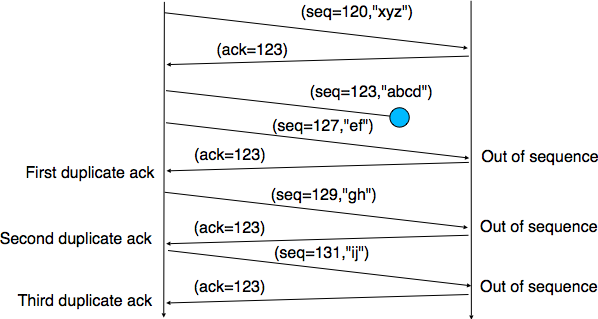
Detecting isolated segment losses¶
As shown above, when an isolated segment is lost the sender receives several duplicate acknowledgments since the TCP receiver immediately sends a pure acknowledgment when it receives an out-of-sequence segment. A duplicate acknowledgment is an acknowledgment that contains the same acknowledgment number as a previous segment. A single duplicate acknowledgment does not necessarily imply that a segment was lost, as a simple reordering of the segments may cause duplicate acknowledgments as well. Measurements [Paxson99] have shown that segment reordering is frequent in the Internet. Based on these observations, the fast retransmit heuristic has been included in most TCP implementations. It can be implemented as follows.
ack arrival:
if tcp.ack == snd.una: # duplicate acknowledgment
dupacks += 1
if dupacks == 3:
retransmit segment(snd.una)
else:
dupacks = 0
# process acknowledgment
This heuristic requires an additional variable in the TCB (dupacks). Most implementations set the default number of duplicate acknowledgments that trigger a retransmission to 3. It is now part of the standard TCP specification RFC 2581. The fast retransmit heuristic improves the TCP performance provided that isolated segments are lost and the current window is large enough to allow the sender to send three duplicate acknowledgments.
The figure below illustrates the operation of the fast retransmit heuristic.

TCP fast retransmit heuristics¶
When losses are not isolated or when the windows are small, the performance of the fast retransmit heuristic decreases. In such environments, it is necessary to allow a TCP sender to use a selective repeat strategy instead of the default go-back-n strategy. Implementing selective-repeat requires a change to the TCP protocol as the receiver needs to be able to inform the sender of the out-of-order segments that it has already received. This can be done by using the Selective Acknowledgments (SACK) option defined in RFC 2018. This TCP option is negotiated during the establishment of a TCP connection. If both TCP hosts support the option, SACK blocks can be attached by the receiver to the segments that it sends. SACK blocks allow a TCP receiver to indicate the blocks of data that it has received correctly but out of sequence. The figure below illustrates the utilization of the SACK blocks.
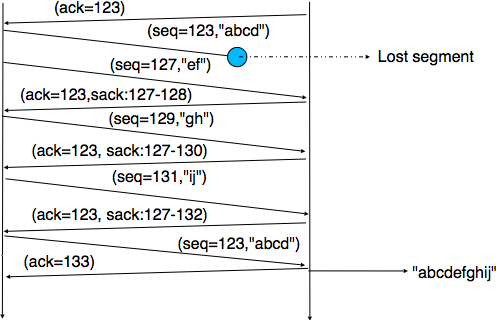
TCP selective acknowledgments¶
A SACK option contains one or more blocks. A block corresponds to all the sequence numbers between the left edge and the right edge of the block. The two edges of the block are encoded as 32 bit numbers (the same size as the TCP sequence number) in an SACK option. As the SACK option contains one byte to encode its type and one byte for its length, a SACK option containing b blocks is encoded as a sequence of \(2+8 \times b\) bytes. In practice, the size of the SACK option can be problematic as the optional TCP header extension cannot be longer than 40 bytes. As the SACK option is usually combined with the RFC 1323 timestamp extension, this implies that a TCP segment cannot usually contain more than three SACK blocks. This limitation implies that a TCP receiver cannot always place in the SACK option that it sends, information about all the received blocks.
To deal with the limited size of the SACK option, a TCP receiver currently having more than 3 blocks inside its receiving buffer must select the blocks to place in the SACK option. A good heuristic is to put in the SACK option the blocks that have most recently changed, as the sender is likely to be already aware of the older blocks.
When a sender receives a SACK option indicating a new block and thus a new possible segment loss, it usually does not retransmit the missing segments immediately. To deal with reordering, a TCP sender can use a heuristic similar to fast retransmit by retransmitting a gap only once it has received three SACK options indicating this gap. It should be noted that the SACK option does not supersede the acknowledgment number of the TCP header. A TCP sender can only remove data from its sending buffer once they have been acknowledged by TCP’s cumulative acknowledgments. This design was chosen for two reasons. First, it allows the receiver to discard parts of its receiving buffer when it is running out of memory without loosing data. Second, as the SACK option is not transmitted reliably, the cumulative acknowledgments are still required to deal with losses of ACK segments carrying only SACK information. Thus, the SACK option only serves as a hint to allow the sender to optimize its retransmissions.
As explained earlier, the TCP Timestamp option RFC 1323 prevents ambiguities while collecting round-trip-time measurements. It plays another very important role in today’s high-bandwidth networks. Since TCP uses 32 bits long sequence numbers, the sequence numbers wrap after the transmission of 4 GBytes of data. With 10 Gbps and soon 100 Gbps interfaces, TCP only needs to transmit during a few seconds before reusing the same sequence number. Given that the Maximum Segment Lifetime is still 2 minutes, several packets, belonging to the same TCP connection could use the same sequence number. If one of these packets is severely delayed through the network, it could reappear at the same time as a packet with the same TCP sequence number. To prevent this problem, most modern TCP implementations associate a TCP timestamp option to each segment on transmission. When a TCP stack receives a TCP segment, it checks that its TCP timestamp is valid and if not the segment is discarded RFC 7323.
TCP connection release¶
TCP, like most connection-oriented transport protocols, supports two types of connection releases :
graceful connection release, where each TCP user can release its own direction of data transfer after having transmitted all data
abrupt connection release, where either one user closes both directions of data transfer or one TCP entity is forced to close the connection (e.g., because the remote host does not reply anymore or due to lack of resources)
The abrupt connection release mechanism is very simple and relies on a single segment having the RST bit set. A TCP segment containing the RST bit can be sent for the following reasons :
a non-SYN segment was received for a non-existing TCP connection RFC 793
by extension, some implementations respond with an RST segment to a segment that is received on an existing connection but with an invalid header RFC 3360. This causes the corresponding connection to be closed and has caused security attacks RFC 4953
by extension, some implementations send an RST segment when they need to close an existing TCP connection (e.g., because there are not enough resources to support this connection or because the remote host is considered to be unreachable). Measurements have shown that this usage of TCP RST is widespread [AW05]
When an RST segment is sent by a TCP entity, it should contain the current value of the sequence number for the connection (or 0 if it does not belong to any existing connection) and the acknowledgment number should be set to the next expected in-sequence sequence number on this connection.
Note
TCP RST wars
The designers of TCP implementations should ensure that two TCP entities never enter a TCP RST war where host A is sending a RST segment in response to a previous RST segment that was sent by host B in response to a TCP RST segment sent by host A … To avoid such an infinite exchange of RST segments that do not carry data, a TCP entity is never allowed to send a RST segment in response to another RST segment.
The normal way of terminating a TCP connection is by using the graceful TCP connection release. This mechanism uses the FIN flag of the TCP header and allows each host to release its own direction of data transfer. As for the SYN flag, the utilization of the FIN flag in the TCP header consumes one sequence number. The figure FSM for TCP connection release shows the part of the TCP FSM used when a TCP connection is released.
FSM for TCP connection release
Starting from the Established state, there are two main paths through this FSM.
The first path is when the host receives a segment with sequence number x and the FIN flag set. The utilization of the FIN flag indicates that the byte before sequence number x was the last byte of the byte stream sent by the remote host. Once all of the data has been delivered to the user, the TCP entity sends an ACK segment whose ack field is set to \((x+1) \pmod{2^{32}}\) to acknowledge the FIN segment. The FIN segment is subject to the same retransmission mechanisms as a normal TCP segment. In particular, its transmission is protected by the retransmission timer. At this point, the TCP connection enters the CLOSE_WAIT state. In this state, the host can still send data to the remote host. Once all its data have been sent, it sends a FIN segment and enter the LAST_ACK state. In this state, the TCP entity waits for the acknowledgment of its FIN segment. It may still retransmit unacknowledged data segments, e.g., if the retransmission timer expires. Upon reception of the acknowledgment for the FIN segment, the TCP connection is completely closed and its TCB can be discarded.
The second path is when the host has transmitted all data. Assume that the last transmitted sequence number is z. Then, the host sends a FIN segment with sequence number \((z+1) \pmod{2^{32}}\) and enters the FIN_WAIT1 state. In this state, it can retransmit unacknowledged segments but cannot send new data segments. It waits for an acknowledgment of its FIN segment (i.e. sequence number \((z+1) \pmod{2^{32}}\)), but may receive a FIN segment sent by the remote host. In the first case, the TCP connection enters the FIN_WAIT2 state. In this state, new data segments from the remote host are still accepted until the reception of the FIN segment. The acknowledgment for this FIN segment is sent once all data received before the FIN segment have been delivered to the user and the connection enters the TIME_WAIT state. In the second case, a FIN segment is received and the connection enters the Closing state once all data received from the remote host have been delivered to the user. In this state, no new data segments can be sent and the host waits for an acknowledgment of its FIN segment before entering the TIME_WAIT state.
The TIME_WAIT state is different from the other states of the TCP FSM. A TCP entity enters this state after having sent the last ACK segment on a TCP connection. This segment indicates to the remote host that all the data that it has sent have been correctly received and that it can safely release the TCP connection and discard the corresponding TCB. After having sent the last ACK segment, a TCP connection enters the TIME_WAIT and remains in this state for \(2*MSL\) seconds. During this period, the TCB of the connection is maintained. This ensures that the TCP entity that sent the last ACK maintains enough state to be able to retransmit this segment if this ACK segment is lost and the remote host retransmits its last FIN segment or another one. The delay of \(2*MSL\) seconds ensures that any duplicate segments on the connection would be handled correctly without causing the transmission of an RST segment. Without the TIME_WAIT state and the \(2*MSL\) seconds delay, the connection release would not be graceful when the last ACK segment is lost.
Note
TIME_WAIT on busy TCP servers
The \(2*MSL\) seconds delay in the TIME_WAIT state is an important operational problem on servers having thousands of simultaneously opened TCP connections [FTY99]. Consider for example a busy web server that processes 10.000 TCP connections every second. If each of these connections remains in the TIME_WAIT state for 4 minutes, this implies that the server would have to maintain more than 2 million TCBs at any time. For this reason, some TCP implementations prefer to perform an abrupt connection release by sending a RST segment to close the connection [AW05] and immediately discard the corresponding TCB. However, if the RST segment is lost, the remote host continues to maintain a TCB for a connection that no longer exists. This optimization reduces the number of TCBs maintained by the host sending the RST segment but at the potential cost of increased processing on the remote host when the RST segment is lost.
Footnotes
- 1
A detailed presentation of all standardization documents concerning TCP may be found in RFC 4614
- 2
Several researchers have analyzed the utilization of TCP and UDP in the global Internet. Most of these studies have been performed by collecting all the packets transmitted over a given link during a period of a few hours or days and then analyzing their headers to infer the transport protocol used, the type of application, … Recent studies include http://www.caida.org/research/traffic-analysis/tcpudpratio/, https://research.sprintlabs.com/packstat/packetoverview.php or http://www.nanog.org/meetings/nanog43/presentations/Labovitz_internetstats_N43.pdf
- 3
This 32 bits counter was specified in RFC 793. A 32 bits counter that is incremented every 4 microseconds wraps in about 4.5 hours. This period is much larger than the Maximum Segment Lifetime that is fixed at 2 minutes in the Internet (RFC 791, RFC 1122).
- 4
On many departmental networks containing Unix workstations, it was common to allow users on one of the hosts to use
rloginRFC 1258 to run commands on any of the workstations of the network without giving any password. In this case, the remote workstation “authenticated” the client host based on its IP address. This was a bad practice from a security viewpoint.- 5
Of course, such a simultaneous TCP establishment can only occur if the source port chosen by the client is equal to the destination port chosen by the server. This may happen when a host can serve both as a client as a server or in peer-to-peer applications when the communicating hosts do not use ephemeral port numbers.
- 6
Sending a packet with a different source IP address than the address allocated to the host is called sending a spoofed packet.
- 7
The full list of all TCP options may be found at https://www.iana.org/assignments/tcp-parameters/
- 8
In practice, only the SYN segment do not have their ACK flag set.
- 9
A complete TCP implementation contains additional information in its TCB, notably to support the urgent pointer. However, this part of TCP is not discussed in this book. Refer to RFC 793 and RFC 2140 for more details about the TCB.
- 10
This TCP segment is then placed in an IP header. We describe IPv6 in the next chapter. The minimum size of the IPv6 (resp. IPv4) header is 40 bytes (resp. 20 bytes).
- 11
A precise estimation of the maximum bandwidth that can be achieved by a TCP connection should take into account the overhead of the TCP and IP headers as well.
- 12
See https://fasterdata.es.net/host-tuning/ for more information on how to tune a TCP implementation
- 13
In theory, a TCP implementation could store the timestamp of each data segment transmitted and compute a new estimate for the round-trip-time upon reception of the corresponding acknowledgment. However, using such frequent measurements introduces a lot of noise in practice and many implementations still measure the round-trip-time once per round-trip-time by recording the transmission time of one segment at a time RFC 2988
- 14
Some security experts have raised concerns that using the real-time clock to set the TSval in the timestamp option can leak information such as the system’s up-time. Solutions proposed to solve this problem may be found in [CNPI09]
- 15
As a TCP client often establishes several parallel or successive connections with the same server, RFC 2140 has proposed to reuse for a new connection some information that was collected in the TCB of a previous connection, such as the measured rtt. However, this solution has not been widely implemented.
